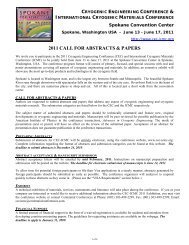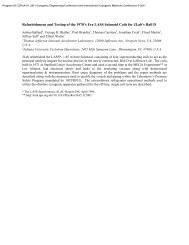CEC Abstracts in PDF format (as of 7/3/07) - CEC-ICMC 2013
CEC Abstracts in PDF format (as of 7/3/07) - CEC-ICMC 2013
CEC Abstracts in PDF format (as of 7/3/07) - CEC-ICMC 2013
Create successful ePaper yourself
Turn your PDF publications into a flip-book with our unique Google optimized e-Paper software.
<strong>CEC</strong> 20<strong>07</strong> - <strong>Abstracts</strong><br />
C3-F-02 Performance <strong>of</strong> Heat Exchanger Models <strong>in</strong><br />
Upside-Down Orientation for the Use <strong>in</strong> HTS Current<br />
Leads for W7-X<br />
R. Lietzow, R. Heller , H. Neumann ,<br />
Forschungszentrum Karlsruhe.<br />
The sc magnet system <strong>of</strong> the W7-X stellarator requires 7 pairs <strong>of</strong><br />
current leads designed for a maximum current <strong>of</strong> 18.2 kA. The<br />
Forschungszentrum Karlsruhe is responsible for the construction,<br />
manufactur<strong>in</strong>g and performance test <strong>of</strong> the current leads. Special<br />
design feature is the <strong>in</strong>stallation <strong>of</strong> the current leads <strong>in</strong> upside-down<br />
orientation, i.e., the low temperature end <strong>of</strong> the current lead is at the<br />
top and the room temperature end at the bottom side lead<strong>in</strong>g to the<br />
problem <strong>of</strong> free convection <strong>in</strong>side the heat exchanger (HEX) due to<br />
density gradients <strong>of</strong> the helium between 4.5 K and 300 K (factor 500,<br />
p = 0.15 MPa). The occurrence <strong>of</strong> free convection leads to a reduced<br />
performance <strong>of</strong> the HEX and results <strong>in</strong> a higher m<strong>as</strong>s flow rate<br />
required for the operation <strong>of</strong> the current leads. To overcome the<br />
problem it w<strong>as</strong> decided to use HTS material <strong>in</strong> the temperature range<br />
between 4.5 K and 60 K. The current lead can then be cooled with 50<br />
K helium. The ma<strong>in</strong> re<strong>as</strong>ons for choos<strong>in</strong>g 50 K are: 50 K helium is<br />
available at a higher pressure level from the refrigerator and the<br />
density gradient between 50 K and 300 K is dr<strong>as</strong>tically reduced<br />
(factor 6, p = 0.6 MPa). This will reduce the problem <strong>of</strong> free<br />
convection.<br />
In the paper the performance <strong>of</strong> HEX mock-ups built <strong>of</strong> different<br />
HEX types will be described. The tests were performed with helium<br />
cool<strong>in</strong>g <strong>of</strong> various temperatures <strong>in</strong> normal and upside-down<br />
orientation. These results were used to select the HEX type for the<br />
W7-X current leads.<br />
C3-F-03 Us<strong>in</strong>g High Temperature Superconduct<strong>in</strong>g<br />
Leads <strong>in</strong> a Magnetic Field<br />
M. A, Green, Lawrence Berkeley National<br />
Laboratory; H. Witte, Oxford University.<br />
HTS leads are <strong>in</strong>cre<strong>as</strong><strong>in</strong>gly used on superconduct<strong>in</strong>g magnets. In most<br />
c<strong>as</strong>es either the magnet is iron shielded or the magnet is actively<br />
shielded so that the stray field at HTS leads is low. There are magnets<br />
where the HTS leads must be located <strong>in</strong> a magnetic field. The two<br />
general types <strong>of</strong> HTS leads that are commercially available are either<br />
leads fabricated from bulk HTS materials or leads fabricated from<br />
oriented HTS materials that have one or two planes <strong>of</strong> favorable<br />
current density. HTS leads have been fabricated from a variety <strong>of</strong><br />
HTS materials. This paper will discuss how two or three types <strong>of</strong><br />
leads are affected by magnetic field. The performance <strong>of</strong> a HTS leads<br />
is determ<strong>in</strong>ed by the high temperature end <strong>of</strong> the lead. The protection<br />
<strong>of</strong> HTS leads from quench<strong>in</strong>g becomes an important consideration.<br />
Examples <strong>of</strong> HTS leads <strong>in</strong> a magnetic field are shown muon<br />
ionization experiment (MICE) magnets.<br />
This work w<strong>as</strong> supported by the Office <strong>of</strong> Science, United States<br />
Department <strong>of</strong> Energy, under DOE contract DE-AC02-<br />
05CH11231<br />
C3-F-04 Implementation <strong>of</strong> HTSC leads for research<br />
cryostats<br />
Y. Shiroyanagi, G. Gopalakrishnan, S. An, D. Ko, T.<br />
J. Gramila, Ohio State University.<br />
Although the advantage <strong>of</strong> HTSC wires have been proven both <strong>in</strong> high<br />
current applications and <strong>in</strong> the presence <strong>of</strong> active cryocoolers, their<br />
implementation <strong>in</strong> liquid Helium research cryostats h<strong>as</strong> not been <strong>as</strong><br />
successful. A central difficulty <strong>in</strong>volves the need to establish a<br />
specific temperature at the warm end <strong>of</strong> the HTSC wire, which is<br />
<strong>in</strong>side the neck <strong>of</strong> the dewar where temperatures are generally not<br />
well known. A novel approach to heat s<strong>in</strong>k<strong>in</strong>g <strong>of</strong> magnet leads[1] h<strong>as</strong><br />
enabled detailed numerical model<strong>in</strong>g <strong>of</strong> the magnet lead system,<br />
<strong>in</strong>clud<strong>in</strong>g the cool<strong>in</strong>g capability <strong>of</strong> the exit<strong>in</strong>g Helium g<strong>as</strong>. This<br />
approach h<strong>as</strong> permitted the <strong>in</strong>corporation <strong>of</strong> HTSC leads <strong>in</strong>to He<br />
research cryostats, while ensur<strong>in</strong>g they rema<strong>in</strong> cold enough to<br />
superconduct. The overall structure <strong>of</strong> magnet lead system <strong>in</strong>clud<strong>in</strong>g<br />
the HTSC wires, its relevant design features, and our characterization<br />
<strong>of</strong> the system will be presented.<br />
[1] A Novel Approach for Magnet Leads: submitted to JLTP.<br />
Thursday, <strong>07</strong>/19/<strong>07</strong> Oral<br />
10:30am - 11:45am<br />
C3-G Low Temperature Superconduct<strong>in</strong>g<br />
Magnet Systems - IV<br />
C3-G-01 CFD Model<strong>in</strong>g <strong>of</strong> ITER Cable-<strong>in</strong>-Conduit<br />
Superconductors. PART V: Comb<strong>in</strong>ed Momentum and<br />
Heat Transfer <strong>in</strong> a Spiral Rib-Roughened Pipe<br />
R. Zan<strong>in</strong>o, Politecnico di Tor<strong>in</strong>o; S. Giors, Varian<br />
s.p.a.<br />
Dual-channel cable-<strong>in</strong>-conduit conductors (CICC) are used <strong>in</strong> the<br />
present design <strong>of</strong> superconduct<strong>in</strong>g magnets for the International<br />
Thermonuclear Experimental Reactor (ITER). Supercritical helium<br />
coolant flows both <strong>in</strong> the annular cable region, and <strong>in</strong> the central<br />
channel, delimited by a (perforated) spiral. As the CICC<br />
axial/transverse size ratio is typically ~ 100, 1D (axial) models are<br />
customarily used for the CICC, but they require constitutive relations<br />
for the transverse fluxes. A novel approach, b<strong>as</strong>ed on Computational<br />
Fluid Dynamics (CFD), w<strong>as</strong> recently proposed [1], [2] to understand<br />
the complex transverse thermal-hydraulic processes <strong>in</strong> an ITER CICC.<br />
A 3D CFD tool, the commercial FLUENT code, w<strong>as</strong> used to compute<br />
the friction factor F <strong>in</strong> spiral rib-roughened pipes, mimick<strong>in</strong>g the<br />
central channel <strong>of</strong> an ITER CICC. The results where validated aga<strong>in</strong>st<br />
compact heat exchanger and ITER-relevant experiments. That<br />
analysis is extended here to the problem <strong>of</strong> comb<strong>in</strong>ed heat/momentum<br />
transfer. The model is first validated aga<strong>in</strong>st 2D and 3D data from<br />
compact heat exchangers and then applied to the analysis <strong>of</strong> central<br />
channel-like geometries relevant for ITER CICC, contribut<strong>in</strong>g to a<br />
better understand<strong>in</strong>g <strong>of</strong> the role <strong>of</strong> geometric parameters to optimize<br />
both F and the Nusselt number (Nu). The question <strong>of</strong> the applicability<br />
<strong>of</strong> the Colburn analogy between F and Nu is also analyzed.<br />
[1]R. Zan<strong>in</strong>o, et al., Adv. Cryo. Eng. 51 (2006) 1009.<br />
[2]R. Zan<strong>in</strong>o, et al., Fus. Eng. Des. 81 (2006) 2605.<br />
C3-G-02 Stability analysis <strong>of</strong> the ITER TF coil conductor<br />
L. Savoldi Richard, R. Zan<strong>in</strong>o, Dipartimento di<br />
Energetica, Politecnico.<br />
The stability analysis <strong>of</strong> the International Thermonuclear<br />
Experimental Reactor (ITER). Toroidal Field (TF) coil Nb3Sn<br />
conductor is performed us<strong>in</strong>g the Mithrandir code [1]. The most<br />
critical conductor <strong>in</strong> the w<strong>in</strong>d<strong>in</strong>g pack, <strong>as</strong> well <strong>as</strong> the most critical<br />
location along it, is identified by the V<strong>in</strong>centa code analysis, which<br />
also provides the <strong>in</strong>itial and boundary conditions for the stability<br />
analysis. Two different disturbances are considered: one short <strong>in</strong> space<br />
and time (1 cm, 1 ms), simulat<strong>in</strong>g a disturbance <strong>of</strong> mechanical nature,<br />
the other longer (3 m, 100 ms) correspond<strong>in</strong>g to AC losses (pl<strong>as</strong>ma<br />
disruption). Both disturbances are applied to the superconduct<strong>in</strong>g (SC)<br />
cable at end-<strong>of</strong>-burn (EOB) <strong>in</strong> the reference ITER <strong>in</strong>ductive operation<br />
scenario. Us<strong>in</strong>g this approach, the Mithrandir analysis can be<br />
restricted to the most critical conductor, us<strong>in</strong>g a much f<strong>in</strong>er grid than<br />
V<strong>in</strong>centa, <strong>in</strong> order to capture the details <strong>of</strong> normal zone <strong>in</strong>itiation and<br />
possible recovery to SC state. The computed results, <strong>in</strong> terms <strong>of</strong><br />
m<strong>in</strong>imum quench energy, are compared to the design values. S<strong>in</strong>ce the<br />
results are strongly <strong>in</strong>fluenced by the choice <strong>of</strong> the heat transfer<br />
coefficient between strands and helium <strong>as</strong> expected, this effect h<strong>as</strong><br />
been also parametrically <strong>in</strong>vestigated.<br />
[1] R.Zan<strong>in</strong>o, S.DePalo and L.Bottura,<br />
Page 40 <strong>of</strong> 53






